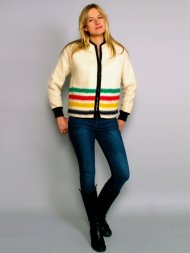
If you’re in the market for a new winter coat, for yourself or as a gift, and you crave something distinctive, consider going vintage. Yes, the craze for all things Mad Men has inspired many modern designers to produce retro-styled pieces for boutiques and department stores alike. But actual vintage coats, as with mid-century modern furniture, are often made from much higher quality materials than the new pieces they’ve inspired, and available at lower prices, if you’re willing to spend some time hunting for the right winter warmer.
Whether a silk-lined swing coat or a structured wool peacoat is more likely to strike your fancy, there are a handful of factors to keep in mind when shopping.
First, as with vintage clothes in general, is the difference between modern and vintage sizes. A woman who wears about a size 8 today would be a size 14 in clothes dating from the 1960s; a size 6 from the era of Jackie O would fit a woman who wears a size 0 in present-day fashions. Beyond the bust, waist and hip measurements usually taken into sizing account, vintage coats often run big in the shoulder—especially for more fitted styles such as peacoats. That can make them appear larger than they actually are. If you’re an eBay shopper, take the time to take your own measurements so that you can find something that actually fits, and don’t be afraid to email the seller with questions about how they measured the garment.
If you’re shopping in Brooklyn, always try things on before buying. “Be sure it’s comfortable in the shoulders and that you have enough room in the arms to wear it over a jacket or sweater,” suggested Pamela Moore, co-proprietor of QP & Monty, a self-described “vintage lifestyle emporium” that sells vintage apparel at several New York City markets, notably Artists & Fleas every weekend in Williamsburg.
“Take a few steps in it—you’ll never wear it if you can’t walk in it.” said Moore. Capes and swing coats pose the opposite pitfall from pea coats and other structured pieces–they often appear larger than the actual fit. Always make sure that the shoulders, neck, and in the case of a swing coat, sleeves, are large enough before purchasing. You don’t want the fabric or buttons to strain anywhere–it’s uncomfortable and unflattering. And, if it’s a shawl cape with side slits for your arms to come through, make sure those slits line up in a way that makes it easy to pop your hands out to pay for your morning coffee or swipe your metrocard. You don’t want your coat to feel like an inconvenience.
As for men’s sizing, half a century ago “patterns were cut for an average height that is much shorter than guys are today,” says QP & Monty co-proprietor Ignacio Quiles. In terms of coats, this means that sleeves and torsos run a bit short; however Quiles stressed that skillful tailoring can overcome this. So if your 6’5 boyfriend or husband wants a vintage coat for Christmas, you probably won’t be able to buy it on December 24 and expect him to wear it out to a Boxing Day bangers and mash brunch without a trip to the tailor. Better yet, go shopping together to figure out whether you can make a fit work.
On the tailoring tip, inspect, pore over and inspect again the seams and lining for any holes or rips. “Ripped lining is super easy to fix if it’s along the seams, but not so much if it’s in the middle of the material,” advised Maresa Ponitch, a Greenpoint-based vintage clothing wholesaler who supplies film sets, stylists and retail stores, including all of the “special and designer vintage collection” for Urban Outfitters. If a wool coat lacks a lining, it may cause sweaters worn underneath to pill, she noted. But, replacing an entire lining is a snap for a skilled seamstress; make sure to factor tailoring into the cost of the coat if you anticipate having to have it relined or extensively repaired.
Other spots to check are the back collar, as well as where the seams intersect in the underarm area. Cuffs can be another problem point, although if they are particularly tatty (or way too short), Quiles suggests having a tailor cover them with velvet or suede.
Next, check out the material itself. Quiles suggests shopping during daylight hours to get the best view of any fading or threadbare areas, particularly holes in wool coats. This often means the coat was once a holiday feast for moths. A slight surface nibble might pose no problems beyond aesthetics. But a hole that goes through to the lining might tear further, especially if it’s in an area that is prone to rubbing such as the underarm area or against a purse. Check fur coats and collars to be sure the pelt isn’t brittle, otherwise it might shed. “Also make sure you can wear your purse in a way that won’t pull on it,” Ponitch said.
If this is a gift, give the garment a good whiff before wrapping. If the coat offers a Proustian recollection of the holiday season because it smells like your grandma’s basement, give it a spin in the dryer for 20 minutes along with a moist towel sprayed with fabric freshener to get rid of any dust. Ponitch notes that a moth ball aroma may be permanently ingrained into the coat, “so make sure you’re okay with that.”
But most importantly, keeping the tips above in mind, remember that vintage coats are one-of-a-kind. A good tailor can work wonders. And, as Quiles said, “If you pass on it, someone else will snap it up and you’ll regret it forever!”




